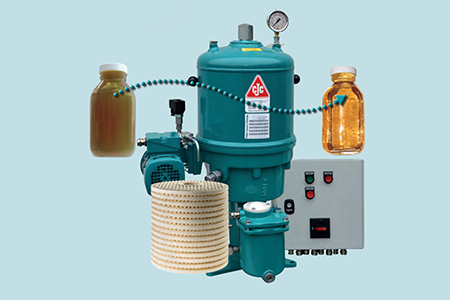Discover how to effectively monitor water contamination in industrial machinery with our expert guide. Learn essential techniques to detect and prevent water-related issues, ensuring optimal performance and longevity. Enhance operational efficiency and protect your equipment with our comprehensive insights.
Industrial machinery is essential in various manufacturing and production processes. As such, it is crucial to maintain these machines in good condition. A critical aspect of machine maintenance is monitoring water contamination in the lubrication and hydraulic systems.
This article will discuss why monitoring water contamination is crucial and how it can be done effectively.
This article is for anyone who owns, operates, or maintains industrial machinery. This includes manufacturers, plant managers, maintenance technicians, and equipment operators. It is also relevant to those involved in machine lubrication and hydraulic system maintenance, such as lubrication technicians, maintenance engineers, and reliability professionals.
Water Contamination
Water contamination can have detrimental effects on industrial machinery. It can cause corrosion, oxidation, and wear in machine components, increasing downtime and repair costs. Water contamination can also affect the performance of lubricants, reducing their effectiveness in reducing friction and wear. In hydraulic systems, water contamination can cause pump damage, fluid breakdown, and system failure.
Water contamination can occur in various ways. Water can sometimes enter the system through leaks or improper maintenance procedures. In other cases, the machine may operate in a humid or wet environment, leading to moisture buildup. Water can also be present in the lubricants or hydraulic fluids themselves.
Monitoring the water content in the machine's lubrication and hydraulic systems is crucial to prevent water contamination. This helps identify potential issues early on, allowing prompt action to prevent further damage.

How to monitor water contamination
There are various methods for monitoring water contamination in industrial machinery. The most common methods include:
Visual inspection
This involves checking for signs of water contamination, such as oil or fluid discoloration, cloudiness, or water droplets.
Water sensors
These sensors are designed to detect the presence of water in lubrication or hydraulic fluids. They can be installed on the machine or as part of a continuous monitoring system.
Karl Fischer titration
This laboratory-based method measures the water content in a lubricant or hydraulic fluid sample. It is an accurate method but requires specialized equipment and expertise.
Infrared spectroscopy
This method involves analyzing the lubricant or hydraulic fluid sample using infrared light to detect the presence of water. It is a non-destructive and fast method, but its accuracy can be affected by other contaminants in the sample.
Dielectric analysis
This method involves measuring the lubricant's or hydraulic fluid's electrical properties to detect the presence of water. It is a non-destructive and fast method that can detect other contaminants in the sample.
Each method has advantages and disadvantages, and the choice of method will depend on factors such as cost, accuracy, and ease of use.
Implementing a monitoring program
To monitor water contamination in industrial machinery, it is essential to implement a comprehensive water contamination monitoring program. This program should include the following steps:
1. Identify critical machinery – Identify the most susceptible to water contamination and focus on them for monitoring.
2. Set water contamination limits – Establish limits for the acceptable water content in lubrication and hydraulic fluids. These limits should be based on the machine manufacturer's recommendations and industry standards.
| Equipment Type | Water Contamination Limit |
| Turbines | < 500 ppm |
| Compressors | < 200 ppm |
| Gearboxes | < 500 ppm |
| Pumps |
Depends on the pump type and manufacturer guidelines |
3. Select monitoring methods – Choose the monitoring methods that are most suitable for the specific machines and operating conditions.
4. Schedule monitoring activities – Determine the frequency of monitoring activities, such as visual inspections, sensor checks, and laboratory-based tests.
5. Record and analyze data – Keep records of monitoring activities and analyze the data to identify trends and potential issues.
6. Take corrective action – If water contamination is detected, take prompt disciplinary action to prevent further damage. This may include draining and replacing contaminated fluids, repairing leaks, or improving maintenance procedures.
Solutions
Water contamination is a significant issue in industrial machinery, leading to costly repairs and downtime. Monitoring water contamination in lubrication and hydraulic systems is crucial to prevent and detect issues early on, allowing for prompt action to be taken. By monitoring water contamination regularly, industrial machinery can operate optimally and last longer, increasing productivity and profitability.
Clean Oil Solutions by Le Price International provides various effective filtration solutions for maintaining clean and dry oil in your industrial machinery. Our solutions can effectively remove water, particulates, and other contaminants from oil, reducing the risk of water contamination in your machinery. With clean oil, you can minimize the risk of wear and tear on machine components, extending the life of your equipment and reducing downtime associated with repairs. Whether looking for offline or online filtration solutions, Clean Oil Solutions has various customizable options to fit your needs.
 ATR Analyser
ATR Analyser
We introduce the ATR Analyser as another essential tool for effective CBM. The ATR Analyser is designed to enhance your maintenance capabilities by providing precise analysis and insights into asset health. You can proactively identify faults and optimize your maintenance operations using the ATR Analyser.
Contact us today for more information on how Clean Oil Solutions and Condition-Based Monitoring can benefit your business.
Sources:
Dagnino, J. T. (2021, August). Oil Analysis Interpretation for Gearboxes. Machinery Lubrication. Sumitomo Drive Technologies
Grewal, M. (n.d.). Calculating the Water Costs of Water-Cooled Air Compressors. Air Best Practices. https://www.airbestpractices.com/technology/air-compressors/calculating-water-costs-water-cooled-air-compressors-part-1
Meza, A. (n.d.). Modern Methods for Monitoring Water Contamination. MachineryLubrication. https://www.machinerylubrication.com/Read/31498/monitoring-water-contamination
Smith, P. (n.d.). PowerFiveTipsforTurbineOilSystemCareand_Maintenance. Amber Resources.
What Does Water Pump Maximum and Rated Head Mean?. National Poly Industries. (n.d.). https://nationalpolyindustries.com.au/2018/06/14/what-does-water-pump-maximum-and-rated-head-mean/

































